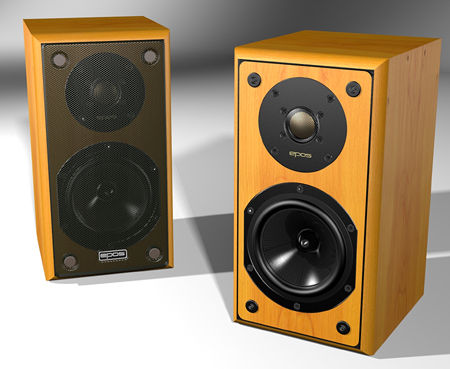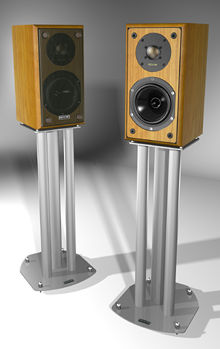| Columns Retired Columns & Blogs |
Epos M5 loudspeaker
Following my favorable experience with Epos Ltd.'s entry-level loudspeaker, the ELS-3 ($329/pair; see my January 2004 review), Roy Hall, of importer Music Hall, called me with some excitement about the new Epos M5 ($650/pair). In a crowded room at the Home Entertainment 2004 show in New York, I did a quick comparison of the M5 and ELS-3 under suboptimal conditions of multiple speakers in the room and Roy answering consumers' questions while pouring scotch for his dealers. Still, I was able to hear enough from the M5 to intrigue me, and with high expectations, I asked for a pair for review.

Design
The M5 is a shielded, biwirable, two-way bass-reflex design. The 1" dome tweeter has a gold-anodized diaphragm of aluminum alloy terminated with a polyamide suspension. Ferrofluid is used to improve the tweeter's power handling and smooth its frequency response. The tweeter's rear-cavity loading and high-efficiency neodymium magnet are claimed to improve its transient response and eliminate temporal smearing. The 5.4" woofer cone is made of an injection-molded polymer that includes a small amount of talc to optimize stiffness. The aluminum chassis is die-cast, and has a phase plug. The M5 is available in light or dark cherry or black—my dark-cherry samples were elegant and attractive.
Normally, I test bookshelf speakers using my trusty Celestion Si stands loaded with sand and lead shot, but designer Mike Creek insisted I test his M5s using Epos' own ST35 stands ($200/pair)—rigid but lightweight aluminum stands designed for use with the M5s, which Creek believes sound best on stands that are "a bit lively." I listened to the speakers on both the Epos and Celestion stands. Creek also recommended that I listen to the M5s with their metal-mesh grilles removed. I heard a slight increase in transparency with the grilles off, but the effect was very subtle.
Expectations
Were you ever, as a kid, given a new toy that you wanted so badly that you clawed at the box because you couldn't wait to touch and experience it? My nine-year-old son does that with Nintendo Gamecube discs, but after 20 years of audio reviewing and dozens of cool audio toys, I've grown jaded. When the M5s arrived, however, I pawed at the box like a kid with a Christmas present. I hooked up the speakers and cued up Maggie and Suzzy Roche's Why the Long Face (CD, Red House RHR CD 179). Reveling in the angelic, silky-rich integration of the voices of the sisters Roche, I immediately knew that the M5 was a special speaker.
In fact, with all the recordings I sampled with the Epos, the speakers exhibited an open, organic, coherent quality that made me feel that I was not merely fixating on audiophile attributes but listening to live musicians. As Art Dudley would say, these speakers played music. Nor did it hurt that, for $650/pair bookshelf speakers, they revealed surprising layers of detail at a very low level of coloration across the entire musical spectrum.
I loved voices through the M5s. While trimming the Christmas tree with the family, I put Cantus' Comfort and Joy: Volume One (CD, Cantus CTS-1204) on repeat for its extremely natural and holographic vocal sonic wallpaper. One of the reasons vocals were particularly convincing through the M5 was the speaker's superior resolution of detail. While listening to Sonic Youth's NYC Ghosts and Flowers (LP, Geffen 0694 0650-1), I found myself focusing more on bassist-vocalist Kim Gordon's perfectly clear diction than on the wailing, shimmering wall of just-tuned Fender Jazzmasters.
This resolution of detail encouraged me to play many piano and percussion recordings. On Everybody Digs Bill Evans (LP, Riverside 1129), I was fixated by the natural sharp attack and long decay of the ride cymbals, and the snare drum's "jump" factor. The perfect timbre, body, and transients of Evans' piano on "Peace Piece" were sufficient to tell me he was playing one of the "better" Steinways. With several recordings I'd played dozen of times before, my notes were filled with references such as "I'd never realized there was a rhythm guitar way down in the mix" and "I never noticed that pianissimo trombone figure against the rear wall of the stage."
Acoustic recordings of single instruments were striking. Although ESP Records' 1960s releases were never known for their sound quality, Sun Ra's The Heliocentric Worlds of Sun Ra, Vol.1 (LP, ESP 1014) startled me with the realism of Robert Cumming's solo bass clarinet and Ra's solo bass marimba.
Charles Wuorinen's Ringing Changes for Percussion Ensemble (LP, Nonesuch 71263) summed up the magic of the M5s. Sure, the speakers revealed detail and "disappeared," and I could tell how far certain instruments were from the microphones, but I'm not talking here about superior soundstaging per se—rather, it was the uncanny way the Eposes revealed the instruments' natural dynamic envelopes.
The M5's highs were impressive—detailed, extended, revealing, and natural. On Kohjiba's Transmigration of the Soul, from Festival (CD, Stereophile STPH007-2), the flute partials were airy and extended, the violins searing and realistically bright and forward. But I'd rather talk about the M5's most impressive strength: the bass. Even in a large room, and at all volume levels over a wide range of program material, the M5's midbass was the most convincing I've heard from a speaker in this price region. The electric bass on Aimee Mann's Bachelor No. 2 or The Last Remains of the Dodo (CD, Super Ego SE002) was warm, powerful, and rocked the room without strain. The bass-synth portamento that opens "Feel No Pain," from Sade's Love Deluxe (CD, Epic 53178), sounded natural and deep—it was the most convincing rendition of this riff I've heard from a bookshelf speaker.

In the fortissimos of Antal Dorati and the London Symphony's recording of Stravinsky's The Firebird (LP, Mercury Living Presence/Classic SR 90226), the bass drum shook the room without compression or strain. My notes on "Lord's Tundra," from Dean Peer's Ucross (LP, Jazz Planet/Classic JP 5002-1), read "the upper partials of the bass shimmer like a violin and the fundamentals ROAR!" The most telling passage from my notebook, however, was something I jotted down while listening to the Ornette Coleman Quartet's Ornette! (LP, Atlantic 1378): "the rich, vibrant, organic, woody, and holographic unity of bassist Scott La Faro."
The word that appeared most often in those notes was bloom. This referred, variously, to the timpani in the Kohjiba, the choir in John Rutter's Requiem (CD, Reference RR-57CD), and the fortissimo passages in Stravinsky's Firebird. But with the M5, I just kept going back to those old jazz recordings. Fans of Linn turntables would appreciate that I felt the M5 rendered the Bill Evans Trio, on Live at Town Hall, Vol.I (LP, Verve V-8683), with "toe-tapping tunefulness." Whether Eric Dolphy was blowing his alto or his bari sax on The Great Concert of Eric Dolphy (LP, Prestige P-34002), the instrument had "burnished bite with silk."
 Although the M5's performance with the Epos ST35 and Celestion Si stands was very close, I ended up agreeing with Mike Creek that the Epos stands imparted an additional liveliness to the sound that was quite convincing, and ended up preferring the ST35s sonically. However, I question the visual match of the modern, attractively designed ST35 with the more traditionally dressed M5, at least with the silver-finished stands I used.
Although the M5's performance with the Epos ST35 and Celestion Si stands was very close, I ended up agreeing with Mike Creek that the Epos stands imparted an additional liveliness to the sound that was quite convincing, and ended up preferring the ST35s sonically. However, I question the visual match of the modern, attractively designed ST35 with the more traditionally dressed M5, at least with the silver-finished stands I used.
Comparisons
I compared the M5 ($650/pair) with Epos' own ELS-3 ($329/pair), as well as with NHT's SB3 ($600/pair) and Nóla's (Alón's) Rascal Mk.II ($600/pair).
The Epos M5 had more midrange detail and a cleaner, more extended bass than the smaller Epos ELS-3, whose highs were also less articulate and sophisticated, and whose high-level dynamic capabilities were somewhat more reserved. However, both Epos speakers have clearly been cut from the same sonic cloth; it was as if, in the ELS-3, some of the M5's many strengths had been turned down a notch.
The NHT SB3's rich, vibrant midrange showed up particularly well on piano and vocal recordings, but with significantly less detail, air, and high-frequency extension than the Epos M5. Transients were also a bit blunted compared with the M5. However, the NHT's bass extension and high-level dynamics surpassed all in this group.
The Rascal Mk.II's low-level dynamic articulation was the equal of the Epos M5's, with excellent detail and an equally natural midrange, though the M5's highs were more delicate and refined. The M5's midbass was a bit more natural, but the Rascal's was more extended. The high-level dynamic capabilities of the two speakers were similar.
Finish
There's not much to add when a speaker such as the M5 excels in the areas of midrange naturalness, detailed and delicate highs, perfectly reproduced transients, uncolored midbass, and a high-level dynamic presentation. To my ears, Mike Creek has designed a winner in the M5, and Epos has established a new benchmark at the very affordable price of $650/pair. Well done!
- Log in or register to post comments




































